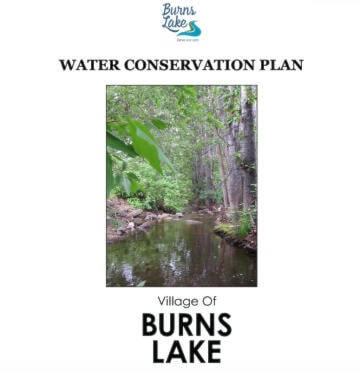The Village of Burns Lake (VBL) compiled a water conservation plan in December 2021, which was received by council during a Jan. 4 meeting.
It’s stated in the plan that a reduction in water consumption will reduce environmental impacts related to water withdrawal from the watershed, reduce costs of operation and maintenance for the water system infrastructure, as well as reduce chemical volumes [for chlorination] needed to treat water.
The plan outlines the current state of the Burns Lake water conservation infrastructure, and provides ways to improve water conservation within the community. According to the report, the current infrastructure is in very good shape, and has been completed with new technology.
In 2021 a new water treatment plant was constructed treating ground water for manganese and arsenic reduction as well as providing secondary disinfection to ensure disinfectant residual is present throughout the distribution system. In 2018 to 2020 numerous upgrades and studies were completed at the VBL well site on Gerow Island as well.
A repair was also made to an underwater watermain with a leaking valve in 2021. An underwater dive team conducted a main water line inspection for two kilometers of waterline. Three air release valves were decommissioned and a report was provided to the VBL.
In terms of ways to reduce water consumption, the report had several strategies to potentially implement. Due to the fact that peak water consumption in the area occurs during the summer months, updates can be completed on facility properties to conserve water, including xeriscaping, which involves planting grasses and plants that are appropriate for the climate to make the landscape more water efficient.
Another suggestion was an educational programming involving informational posters highlighting any newly-installed, water-efficient technologies in facility bathrooms where the public can easily access them.
One other key aspect of the plan involved a discussion around rate structures and water meters. Currently, just six per cent of residential service connectors are metered, along with 30 per cent of industrial, commercial and institutional service connections.
When water meters aren’t in place, a flat rate structure is generally used, which means every customer is billed the same regardless of their water consumption. Instituting metering would allow water consumption to be measured for each individual, and that individual would be charged depending on how much water they use.
According to the conservation plan, with a metering structure, customers would be more likely to conserve water, because they would be more motivated to reduce their volumetric consumption to save money. The problem is, installing a structure like that could be costly.
An estimate from 2013 indicates that it would cost the Village close to $400,000 to install meters on every residential service connector. On top of that, once they’re installed, additional resources would need to be allocated to read the meters and process the data.
READ MORE: Burns Lake Village Heights master plan continues
READ MORE: Passive weir could be constructed on Endako river
Have a story tip? Email:
Eddie Huband
Multimedia Reporter
eddie.huband@ldnews.net
Like us on Facebook and follow us on Twitter.
